Experimental Research on Bonded Anchorage of Carbon Fiber Reinforced Polymer Prestressed Strands
Abstract
:1. Introduction
2. Experimental Program
2.1. Material Test
2.1.1. CFRP Strand
2.1.2. Bonding Medium
2.2. Anchorage Test
2.2.1. Specimen Preparation
2.2.2. Measuring Point Layout and Loading Scheme
3. Experimental Results and Discussions
3.1. Form of Destruction
3.2. Stress–Strain Relationship
3.3. Influence of Anchor Taper
3.4. Influence of Bonding Medium
4. Conclusions
- The bonded anchorage of CFRP prestressed strand with 200 mm anchor is most efficient in this study, as the taper of the 200 mm anchor is the largest. The average anchoring efficiency coefficient of the 200 mm anchor was 96.4%, which is 3.7% and 2.6% higher than the average anchoring efficiency coefficient of 220 mm and 250 mm anchors, respectively. This shows that the taper is the key factor affecting the anchoring performance of this kind of anchor.
- The bonded anchorage of the CFRP strand with a 200 mm anchor is the most reliable, as all the specimens of the 200 mm anchor demonstrated less difference of anchoring efficiencies and exhibited consistency in the failure mode by demonstrating the explosive failure of the CFRP stand. On the contrary, the difference in anchoring efficiencies between the specimens of 220 mm and 250 mm anchors is quite large, at 18.1% and 12.1%, respectively.
- When epoxy resin mortar is used as the bonding medium of the 200 mm anchor, the anchoring efficiency is also higher, with less difference in anchoring efficiencies between the specimens; all CFRP strands are explosively damaged. Adding an appropriate amount of quartz sand into the epoxy resin helps to improve the comprehensive performance of the bonding medium, and to a certain extent, improves the overall anchoring performance of the anchor and the stress of the CFRP strand as the dispersion of the stress–strain curves of each wire for the anchor with epoxy resin mortar medium is small, and it is always consistent before the peak value; the force of each wire of the CFRP strand is relatively uniform.
- Both the epoxy resin and epoxy resin mortar bonding medium can anchor the CFRP strand reliably, where the anchor with the epoxy resin medium has demonstrated the highest anchoring efficiency, and the anchor with epoxy resin mortar has shown the overall anchoring performance better than that of the anchor with the epoxy resin bonding medium.
- The bonded anchorage of the CFRP prestressed strand with infused with UHPC-GJL bonding medium and the anchoring performance of the anchor is the worst; the CFRP strands are all pulled out, and the average anchoring efficiency coefficient is the lowest, at only 44.5%. Therefore, the UHPC-GJL bonding medium cannot reliably anchor CFRP strands, because the coupling between this bonding medium and the CFRP material is not good, and the two cannot be well bonded.
Author Contributions
Funding
Institutional Review Board Statement
Data Availability Statement
Conflicts of Interest
References
- Hou, S.; Long, P.; Zhuge, P.; Liu, M. Anchoring Mechanism Test of CFRP Cable-Strand Bonded Anchorage. Chin. J. Highw. 2013, 26, 7. [Google Scholar]
- Liu, Y.; Tafsirojjaman, T.; Dogar, A.U.R.; Hückler, A. Shrinkage behavior enhancement of infra-lightweight concrete through FRP grid reinforcement and development of their shrinkage prediction models. Constr. Build. Mater. 2020, 258, 119649. [Google Scholar] [CrossRef]
- Tafsirojjaman, T.; Fawzia, S.; Thambiratnam, D.P.; Wirth, N. Performance of FRP strengthened full-scale simply-supported circular hollow steel members under monotonic and large-displacement cyclic loading. Eng. Struct. 2021, 242, 112522. [Google Scholar] [CrossRef]
- Liu, Y.; Tafsirojjaman, T.; Dogar, A.U.R.; Hückler, A. Bond behaviour improvement between infra-lightweight and high strength concretes using FRP grid reinforcements and development of bond strength prediction models. Constr. Build. Mater. 2021, 270, 121426. [Google Scholar] [CrossRef]
- Tafsirojjaman, T.; Fawzia, S.; Thambiratnam, D.P.; Zhao, X.-L. FRP strengthened SHS beam-column connection under monotonic and large-deformation cyclic loading. Thin-Walled Struct. 2021, 161, 107518. [Google Scholar] [CrossRef]
- Tafsirojjaman, T.; Fawzia, S.; Thambiratnam, D.; Zhao, X.-L. Numerical investigation of CFRP strengthened RHS members under cyclic loading. Structures 2020, 24, 610–626. [Google Scholar] [CrossRef]
- Fakri Muda, M.; Hisbany Mohd Hashim, M.; Khairul Kamarudin, M.; Hairil Mohd, M.; Tafsirojjaman, T.; Abdul Rahman, M.; Kee Paik, J. Burst Pressure Strength of Corroded Subsea Pipelines Repaired with Composite Fiber-Reinforced Polymer Patches. Eng. Fail. Anal. 2022, 136, 106204. [Google Scholar] [CrossRef]
- Pan, Y.; Yan, D. Study on the durability of GFRP bars and carbon/glass hybrid fiber reinforced polymer (HFRP) bars aged in alkaline solution. Compos. Struct. 2021, 261, 113285. [Google Scholar] [CrossRef]
- Duo, Y.; Liu, X.; Liu, Y.; Tafsirojjaman, T.; Sabbrojjaman, M. Environmental impact on the durability of FRP reinforcing bars. J. Build. Eng. 2021, 43, 102909. [Google Scholar] [CrossRef]
- Tafsirojjaman, T.; Ur Rahman Dogar, A.; Liu, Y.; Manalo, A.; Thambiratnam, D.P. Performance and design of steel structures reinforced with FRP composites: A state-of-the-art review. Eng. Fail. Anal. 2022, 138, 106371. [Google Scholar] [CrossRef]
- Tafsirojjaman, T.; Fawzia, S.; Thambiratnam, D.P. Structural behaviour of CFRP strengthened beam-column connections under monotonic and cyclic loading. Structures 2021, 33, 2689–2699. [Google Scholar] [CrossRef]
- Liu, Y.; Zhang, H.-T.; Tafsirojjaman, T.; Ur, A.; Dogar, R.; Alajarmeh, O.; Yue, Q.-R.; Manalo, A. A novel technique to improve the compressive strength and ductility of glass fiber reinforced polymer ( GFRP ) composite bars. Constr. Build. Mater. 2022, 326, 126782. [Google Scholar] [CrossRef]
- Tafsirojjaman, T.; Fawzia, S.; Thambiratnam, D.; Zhao, X.L. Seismic strengthening of rigid steel frame with CFRP. Arch. Civ. Mech. Eng. 2019, 19, 334–347. [Google Scholar] [CrossRef]
- Ji, Y.; Han, Q.; Lu, Y.; Liu, X. Application Research of CFRP in Civil Engineering. Struct. Eng. 2014, 000, 210–219. [Google Scholar]
- Yan, Z. Application of FRP composite materials in civil engineering. China High-Tech Zone 2017, 1, 26. [Google Scholar]
- Yan, Q.; Zhang, J. Application and Development of Fiber Reinforced Composites in Civil Engineering. Sci. Technol. Eng. 2021, 21, 9. [Google Scholar]
- Nanni, A.; Bakis, C.E.; O’Neil, E.F.; Dixon, T.O. Performance of FRP Tendon-Anchor Systems for Prestressed Concrete Structures. PCI J. 1996, 41, 34–44. [Google Scholar] [CrossRef]
- Ye, H.; Tang, S.; Duan, Z.; Liu, J.; Yang, J. 2020 Research Progress on the Application of Prestressed Fiber Reinforced Composites (FRP) in Bridge Structure Reinforcement. Chin. J. Civ. Environ. Eng. (Engl. Chin.) 2021, 43, 5. [Google Scholar]
- Li, C.; Guo, R.; Xian, G.; Li, H. Innovative compound-type anchorage system for a large-diameter pultruded carbon/glass hybrid rod for bridge cable. Mater. Struct. 2020, 53, 73. [Google Scholar] [CrossRef]
- Xiong, Z.; Liu, Y.; Zuo, Y.; Xin, H. Shear performance assessment of sand-coated GFRP perforated connectors embedded in concrete. Materials 2019, 12, 1906. [Google Scholar] [CrossRef]
- Ali, A.H.; Mohamed, H.M.; Benmokrane, B.; ElSafty, A.; Chaallal, O. Durability performance and long-term prediction models of sand-coated basalt FRP bars. Compos. Part B Eng. 2019, 157, 248–258. [Google Scholar] [CrossRef]
- Yu, T.; Fang, Z. Static test research on CFRP strand bonded anchorage. Sino-Foreign Highw. 2017, 37, 5. [Google Scholar]
- Liu, R.; Gao, L.; Chen, B.; Xie, G.; Cai, D. Design and static load test research of CFRP strand clip-bonded tandem anchorage. Sino-Foreign Highw. 2015, 35, 4. [Google Scholar]
- Liu, R.; Gong, X.; Li, C.; Lv, Z.; Mei, K. Anchorage performance test of CFRP cables for cable-stayed bridges. Ind. Archit. 2006, 36, 5. [Google Scholar]
- Sun, L.; Ping, Z.; Xu, Y.; Chu, B. Experimental and theoretical research on bearing capacity evaluation of CFRP-reinforced anchorage. Chin. J. Water Resour. Water Eng. 2018, 29, 6. [Google Scholar]
- Puigvert, F.; Crocombe, A.D.; Gil, L. Fatigue and creep analyses of adhesively bonded anchorages for CFRP tendons. Int. J. Adhes. Adhes. 2014, 54, 143–154. [Google Scholar] [CrossRef]
- Zhang, B.B. Design and evaluation of a new bond-type anchorage system for fiber reinforced polymer tendons. Can. J. Civ. Eng. 2004, 31, 14–26. [Google Scholar] [CrossRef]
- Noisternig, J.F. Carbon Fibre Composites as Stay Cables for Bridges. Appl. Compos. Mater. 2000, 7, 139–150. [Google Scholar] [CrossRef]
- Feng, Q. Exploration and Application of Fatigue Properties of CFRP Tendon Anchors. Master’s Thesis, Jiangsu University, Zhenjiang, China, 2019. [Google Scholar]
- Jiang, C.; Wu, C.; Jiang, X. The law of uniform corrosion and pitting corrosion of high-strength steel wires of bridge cables. J. Tongji Univ. Nat. Sci. Ed. 2018, 46, 7. [Google Scholar]
- Meier, U.; Farshad, M. Connecting high-performance carbon-fiber-reinforced polymer cables of suspension and cable-stayed bridges through the use of gradient materials. J. Comput.-Aided Mater. Des. 1996, 3, 379–384. [Google Scholar] [CrossRef]
- Sentry, M.R. In Investigation into the Durability and Performance Effects of CFRP Strand in Permanent Ground Anchors. Ph.D. Thesis, Monash University, Melbourne, Australia, 2010. [Google Scholar]
- Huang, Z.; Cen, X.; Liu, H. Experimental Research on Bonding Properties of Carbon Fiber Reinforcement and Reactive Powder Concrete. Chin. J. Railw. Sci. Eng. 2006, 3, 5. [Google Scholar]
- Fang, Z.; Zhang, K.; Tu, B. Experimental investigation of a bond-type anchorage system for multiple FRP tendons. Eng. Struct. 2013, 57, 364–373. [Google Scholar] [CrossRef]
- Zang, N. Study on the Fatigue Performance of CFRP Bar-Bonded Anchorage System. Master’s Thesis, Jiangsu University, Zhenjiang, China, 2016. [Google Scholar]
- Wang, Z. An Experimental Study on the Anchorage Performance of CFRP Bar-Bonded Anchors. Master’s Thesis, Chang’an University, Xi’an, China, 2017. [Google Scholar]
- Liang, D. Experimental Study on Static Performance of Carbon Fiber (CFRP) Prestressed Tendon-Stayed Anchorage System. Master’s Thesis, Hunan University, Changsha, China, 2004. [Google Scholar]
- Bujun, Y.U.; Cai, W.; Liang, S.; Zhang, J. Design and Test Research of Bond- type Anchorage for Single CFRP Tendon. J. Yancheng Inst. Technol. (Nat. Sci. Ed.) 2014, 1, 52–55. [Google Scholar]
- Mei, K.; Lv, Z. Analysis of Static Characteristics of CFRP Stay Cables. Chin. J. Highw. 2004, 17, 3. [Google Scholar]
- Mei, K.; Lv, Z.; Zhang, J. Experimental Research on CFRP Reinforced Bonded Anchorage and Application Analysis of Real Bridges. Chin. J. Highw. 2016, 29, 53–60. [Google Scholar]
- GB/T2567-2008; Test Methods for Properties of Resin Casting Body. China Building Materials Federation, National Standard of the People’s Republic of China: Beijing, China, 2008.
- GB/T 50448-2008; Application of Cement-Based Grouting Materials. National Standard of the People’s Republic of China: Beijing, China, 2008.


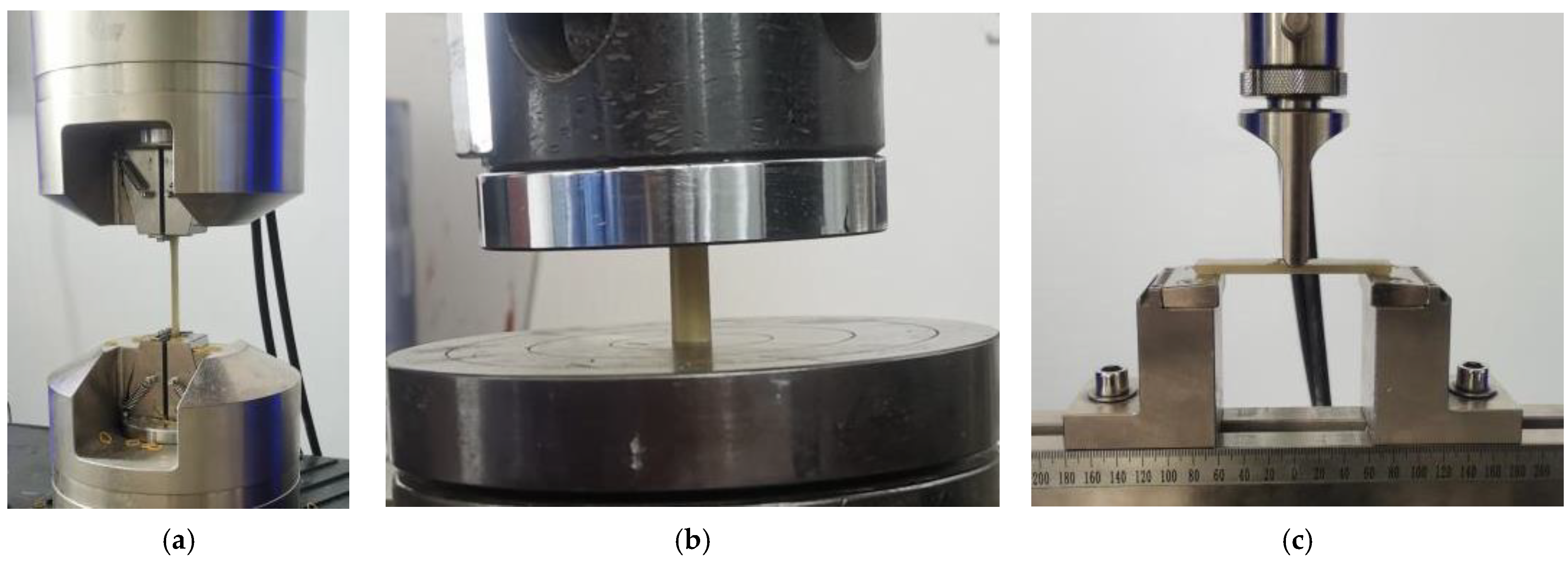
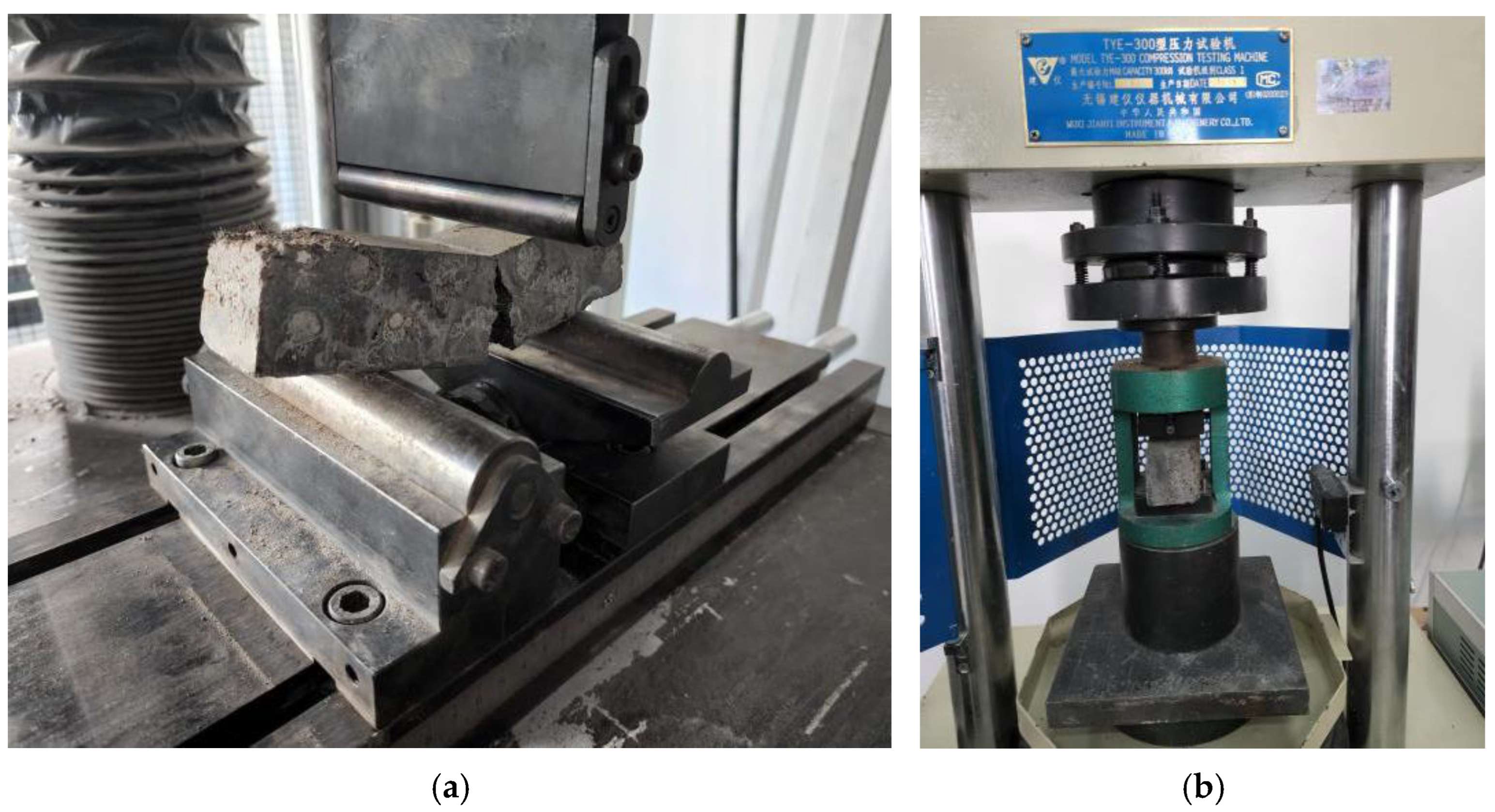

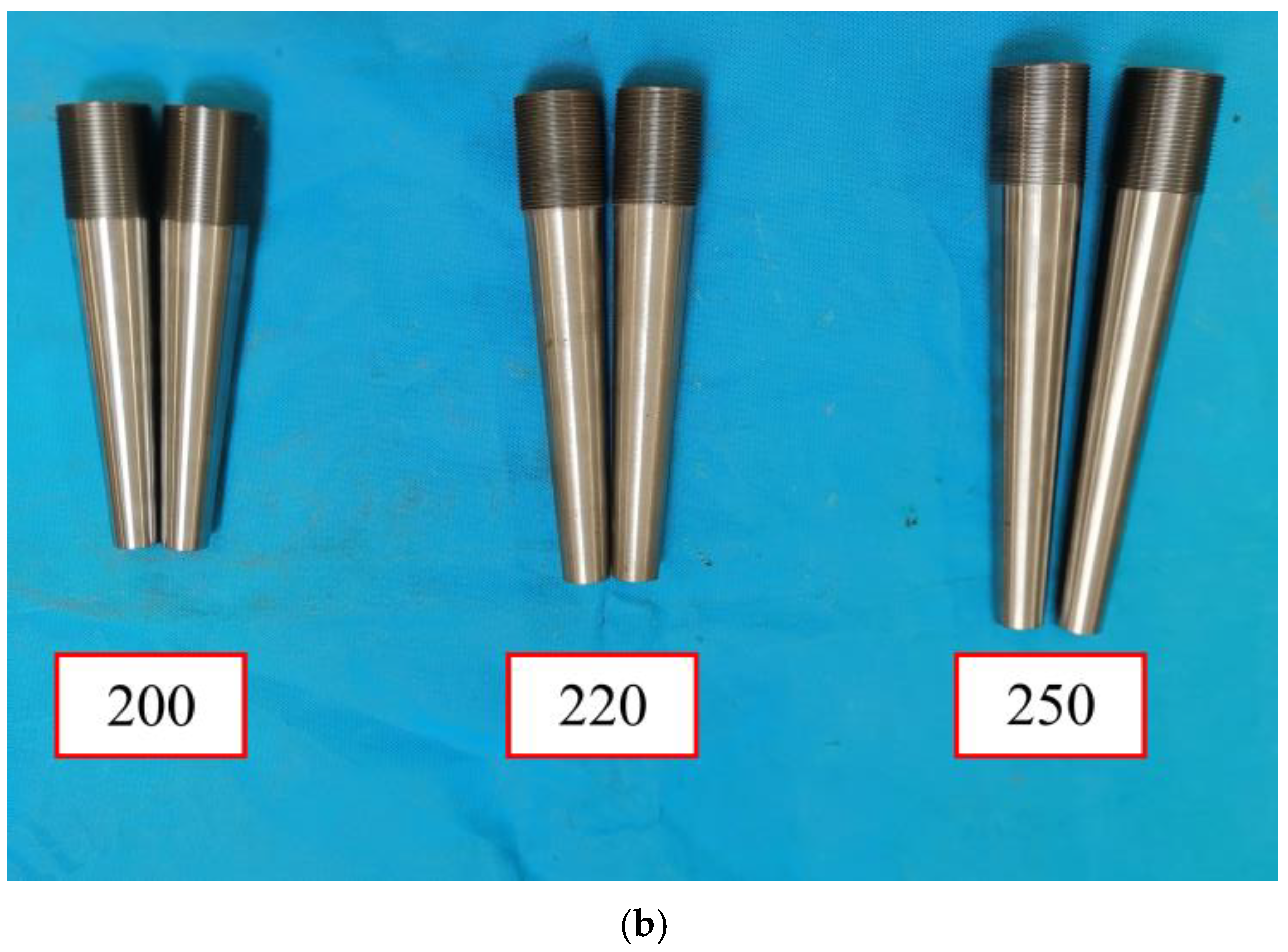

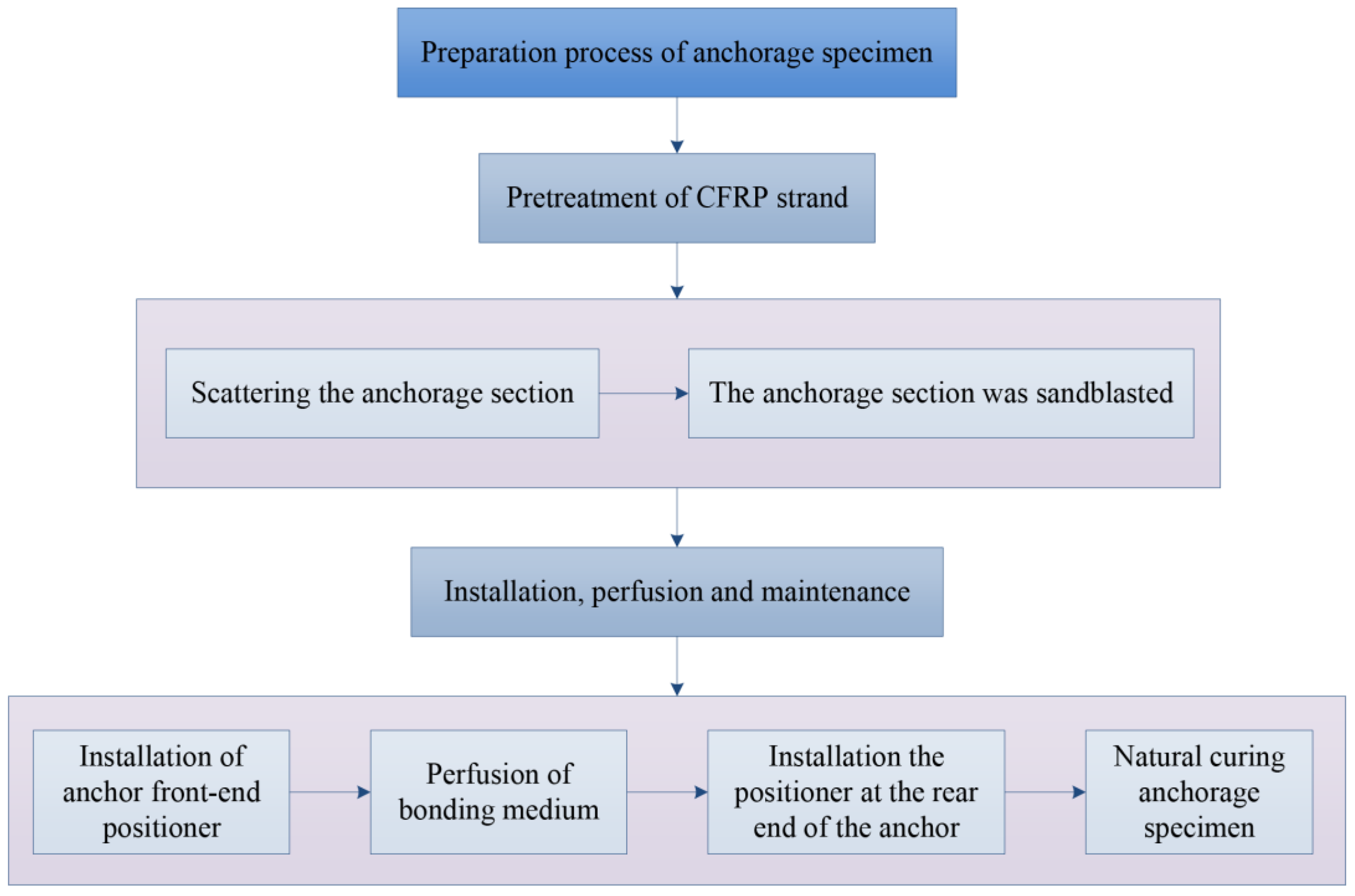



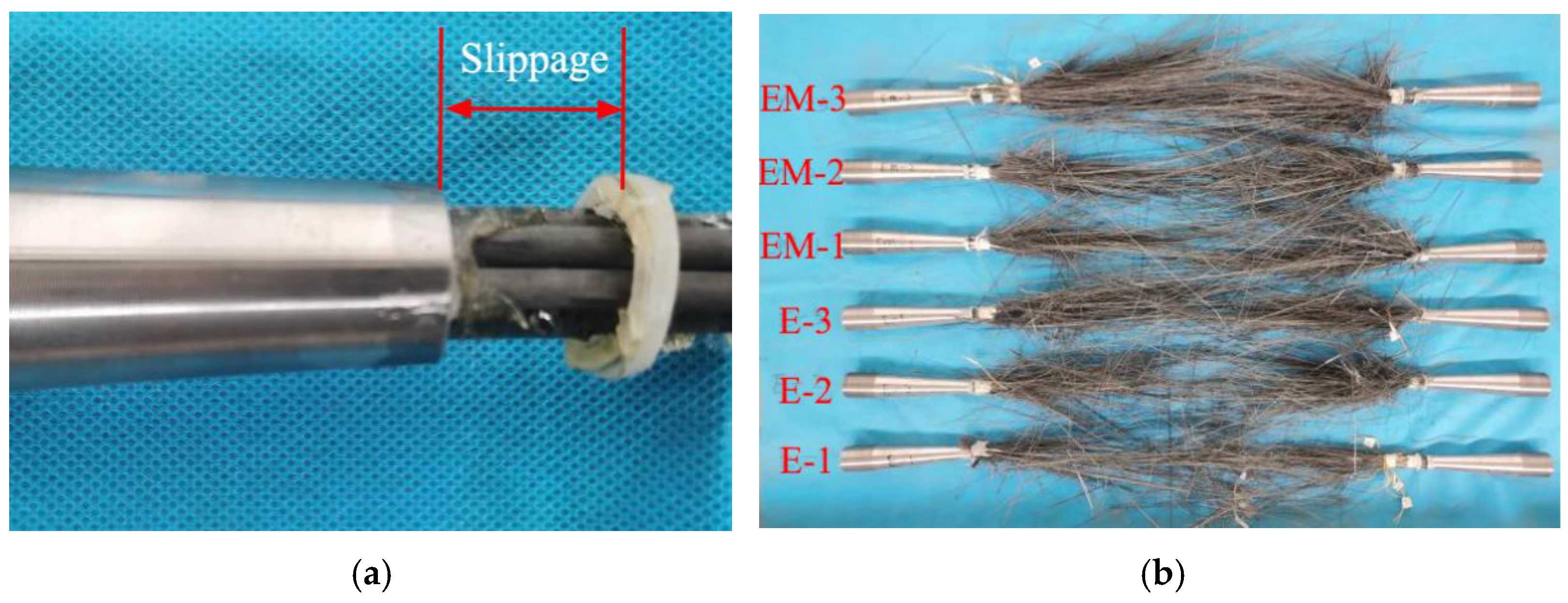


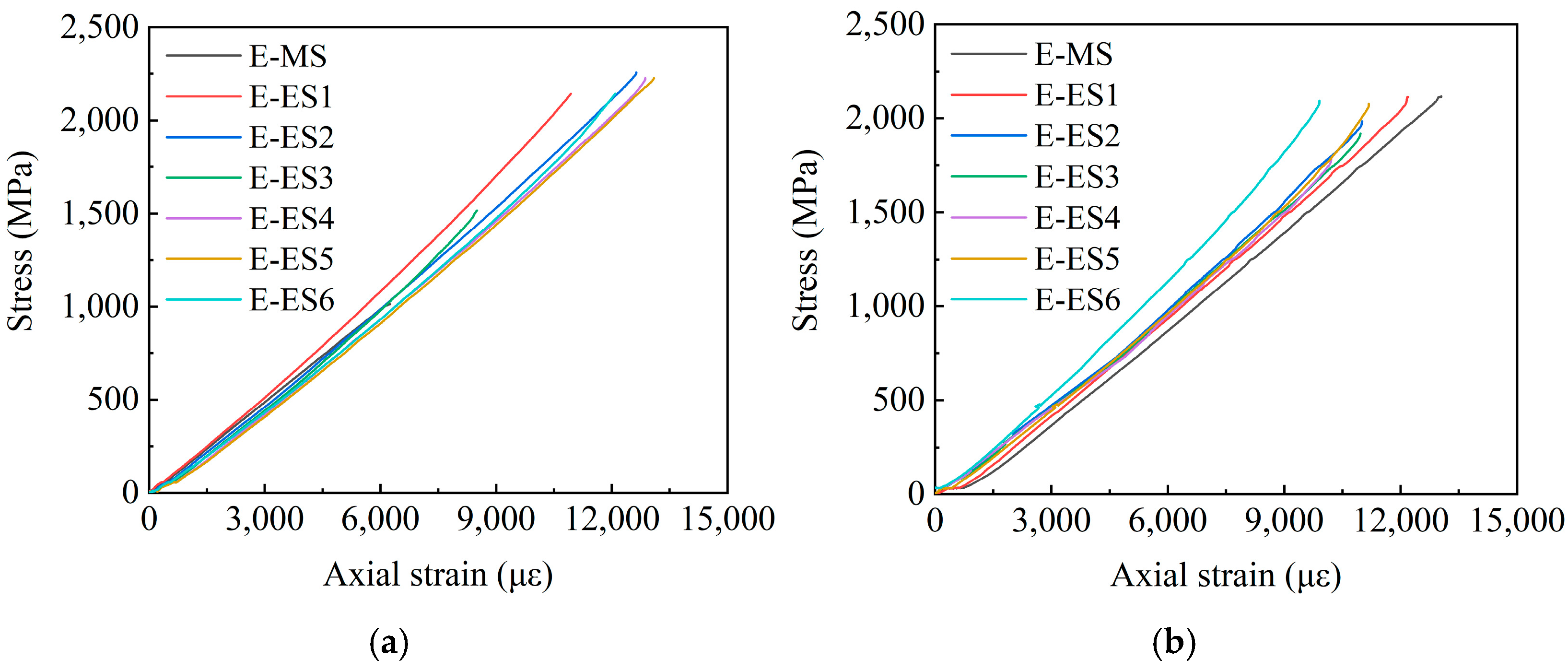



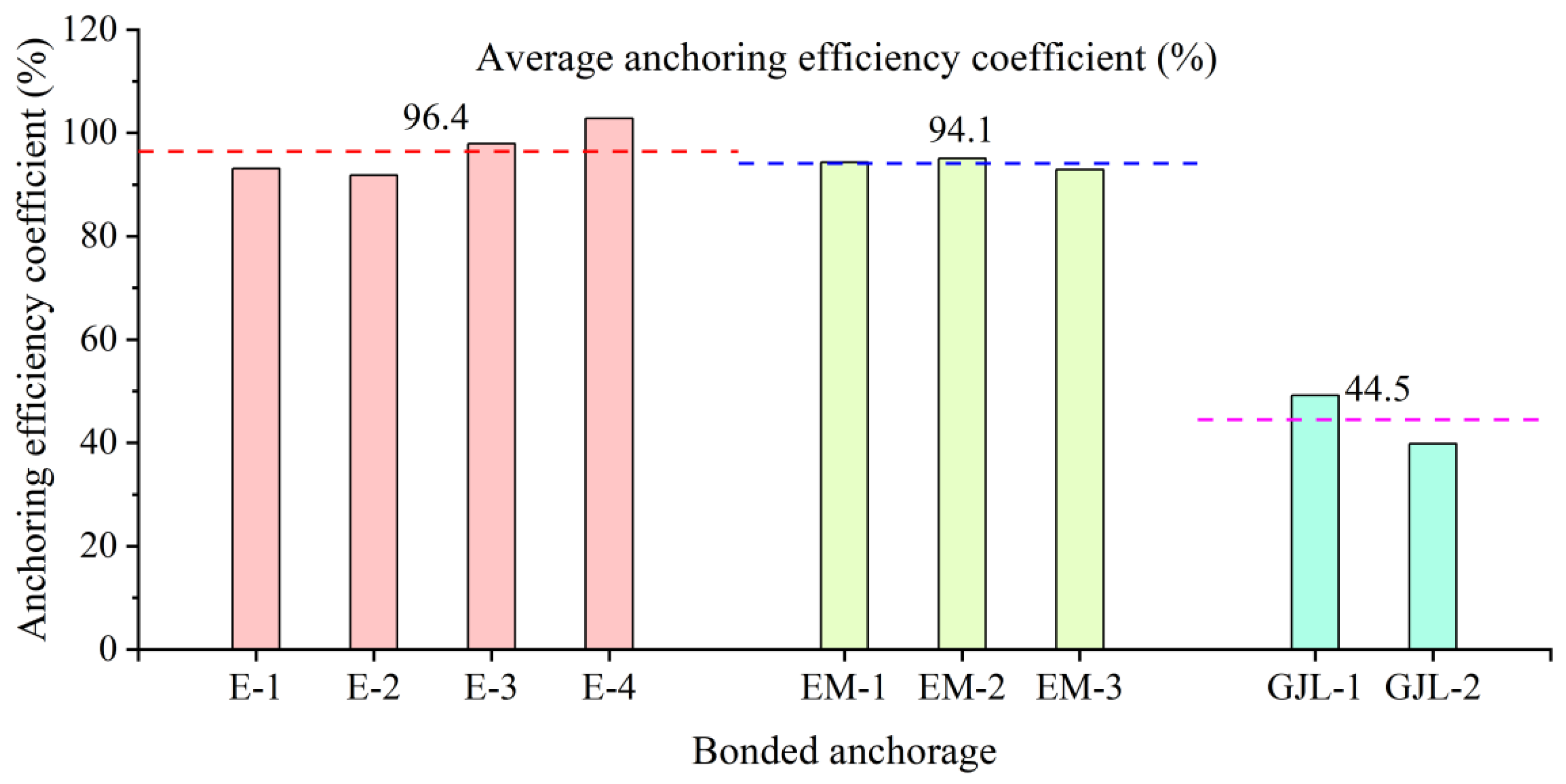
| Material Properties | Average Tensile Strength/ MPa | Elastic Modulus/ GPa | Density/ (kg·m−3) | Ultimate Elongation % | Fiber Volume Fraction % |
|---|---|---|---|---|---|
| CFRP strand | 2703.78 | 170 | 1.65 | 1.50 | 71 |
| Material Properties | Average Tensile Strength/ MPa | Average Compressive Strength/ MPa | Average Bending Strength/ MPa |
|---|---|---|---|
| Epoxy resin | 63.66 | 88.36 | 141.64 |
| Epoxy resin mortar | 33.20 | 85.94 | 60.95 |
| Material Properties | Average Breaking Strength/ MPa | Average Compressive Strength/ MPa |
|---|---|---|
| UHPC-GJL | 33.37 | 168.50 |
| Group Name | Adhesive Medium | Specimen Number | Specimen Length [mm] | Free Segment Length [mm] | Form of Destruction | Factory Standard Ultimate Load [kN] | Actual Ultimate Load [kN] | Anchoring Efficiency Coefficient μ [%] | Anchoring Efficiency Coefficient Variance |
|---|---|---|---|---|---|---|---|---|---|
| 200-X | Epoxy resin | 200-1 | 1100 | 700 | Explosion | 371.6 | 345.8 | 93.1 | 18.8 |
| 200-2 | 1100 | 700 | Explosion | 371.6 | 341.3 | 91.8 | |||
| 200-3 | 1100 | 700 | Explosion | 371.6 | 363.8 | 97.9 | |||
| 200-4 | 1100 | 700 | Explosion | 371.6 | 382.0 | 102.8 | |||
| 220-X | Epoxy resin | 220-1 | 1140 | 700 | Pulling out | 371.6 | 310.6 | 83.6 | 81.9 |
| 220-2 | 1140 | 700 | Pulling out | 371.6 | 378.0 | 101.7 | |||
| 250-X | Epoxy resin | 250-1 | 1200 | 700 | Explosion | 371.6 | 371.0 | 99.8 | 36.6 |
| 250-2 | 1200 | 700 | Pulling out | 371.6 | 325.8 | 87.7 |
| Group Name | Adhesive Medium | Specimen Number | Specimen Length [mm] | Free Segment Length [mm] | Form of Destruction | Factory Standard Ultimate Load [kN] | Actual Ultimate Load [kN] | Anchoring Efficiency Coefficient μ [%] | Anchoring Efficiency Coefficient Variance |
|---|---|---|---|---|---|---|---|---|---|
| E-X | Epoxy resin | 200-1 | 1100 | 700 | Explosion | 371.6 | 345.8 | 93.1 | 18.8 |
| 200-2 | 1100 | 700 | Explosion | 371.6 | 341.3 | 91.8 | |||
| 200-3 | 1100 | 700 | Explosion | 371.6 | 363.8 | 97.9 | |||
| 200-4 | 1100 | 700 | Explosion | 371.6 | 382.0 | 102.8 | |||
| EM-X | Epoxy resin mortar | EM-1 | 1100 | 700 | Explosion | 371.6 | 350.6 | 94.3 | 1.2 |
| EM-2 | 1100 | 700 | Explosion | 371.6 | 353.4 | 95.1 | |||
| EM-3 | 1100 | 700 | Explosion | 371.6 | 345.3 | 92.9 | |||
| GJL-X | UHPC-GJL | GJL-1 | 1100 | 700 | Pulling out | 371.6 | 183.0 | 49.2 | 22.1 |
| GJL-2 | 1100 | 700 | Pulling out | 371.6 | 147.9 | 39.8 |
Publisher’s Note: MDPI stays neutral with regard to jurisdictional claims in published maps and institutional affiliations. |
© 2022 by the authors. Licensee MDPI, Basel, Switzerland. This article is an open access article distributed under the terms and conditions of the Creative Commons Attribution (CC BY) license (https://creativecommons.org/licenses/by/4.0/).
Share and Cite
Jia, L.; Wang, B.; Tafsirojjaman, T. Experimental Research on Bonded Anchorage of Carbon Fiber Reinforced Polymer Prestressed Strands. Polymers 2022, 14, 4015. https://doi.org/10.3390/polym14194015
Jia L, Wang B, Tafsirojjaman T. Experimental Research on Bonded Anchorage of Carbon Fiber Reinforced Polymer Prestressed Strands. Polymers. 2022; 14(19):4015. https://doi.org/10.3390/polym14194015
Chicago/Turabian StyleJia, Liqiang, Bo Wang, and T. Tafsirojjaman. 2022. "Experimental Research on Bonded Anchorage of Carbon Fiber Reinforced Polymer Prestressed Strands" Polymers 14, no. 19: 4015. https://doi.org/10.3390/polym14194015
APA StyleJia, L., Wang, B., & Tafsirojjaman, T. (2022). Experimental Research on Bonded Anchorage of Carbon Fiber Reinforced Polymer Prestressed Strands. Polymers, 14(19), 4015. https://doi.org/10.3390/polym14194015







